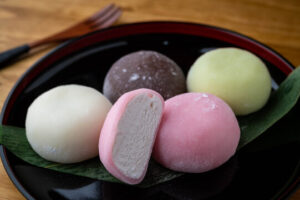Mochi: Nutrition, Health Benefits, and Smart Nutrition
1. Introduction

Mochi is a traditional Japanese dessert which is now becoming popular among health-conscious consumers around the world, including India.
On websites like “Smart Nutrition Hub,” people now look for global dishes from a nutritional perspective, in which mochi holds a special place.
2. History and Cultural Significance of Mochi
Mochi has a history of thousands of years in Japan.
It is eaten during festivals and the New Year in Japan for good fortune and longevity.
It is similar to Indian culture — like til-gud (sesame and jaggery), in Japan, there is mochi!
3. Nutritional Content of Mochi
44g Mochi Energy-96kcal , Protein – 1g ,Carbohydrate – 22 g, Fat- 0 g, Vitamins/Minerals- Minimal amount
High in carbohydrates, low in fat and protein, naturally gluten-free.
No trans fat, no cholesterol.
Considered an energy-rich snack for active lifestyles or athletes.
4. Mochi and Smart Nutrition: Health Benefits

Instant Energy: Carbohydrates quickly convert to glucose and fuel muscles, bringing instant energy to the body.
Low-Calorie Snack: Suitable for weight management.
Portable, long-lasting: A healthy snacking option.
Helpful in Gluten Allergy: Beneficial for people with celiac disease or gluten sensitivity.
Fortification in Modern Mochi: Now superfoods (chia, seeds, nuts, supergreens) are added — aligning well with current smart nutrition trends.
5. Mochi: Risks and Precautions
Excessive consumption of mochi may raise blood sugar levels.
Especially difficult for children and elderly to swallow, which can cause problems during eating — hence, it should be served in small pieces to them.
Most commercially available mochi has high added sugar content.
Diabetic patients should consume it in limited amounts or consult a doctor.
6. Healthy Varieties and Recipes of Mochi
Fruit-Filled Mochi: Fresh fruits and nut butter fillings increase nutrition.
Superseed Mochi: Flax, chia, pumpkin seeds add fiber and Omega-3.
Low-Sugar Mochi: Try making low-sugar versions at home — using coconut sugar, date paste, etc.
Vegan Mochi: Dairy-free fillings like coconut cream, mung bean paste, etc.
Smart Servings Guide for Mochi
Eat 2–3 small pieces per day; overconsumption may cause heaviness in the stomach.
Always chew slowly and do not swallow in one go.
Give to children in small bite-sized pieces.
7. Food Science: Mochi in Context of Modern Nutrition Trends
Compared to processed snacks, mochi is fully naturally gluten-free, high-energy, and a good digestive snack.
Its popularity is rising in India and many other countries with growing health and fitness communities — especially among young working-class and gym-goers.
8. Conclusion
Mochi is becoming a global superfood — if chosen in moderation and in healthy variants, it can be very beneficial from a nutritional and health standpoint.
For websites like “Smart Nutrition Hub,” focusing on mochi will connect users with global food trends and also promote a healthy lifestyle.
